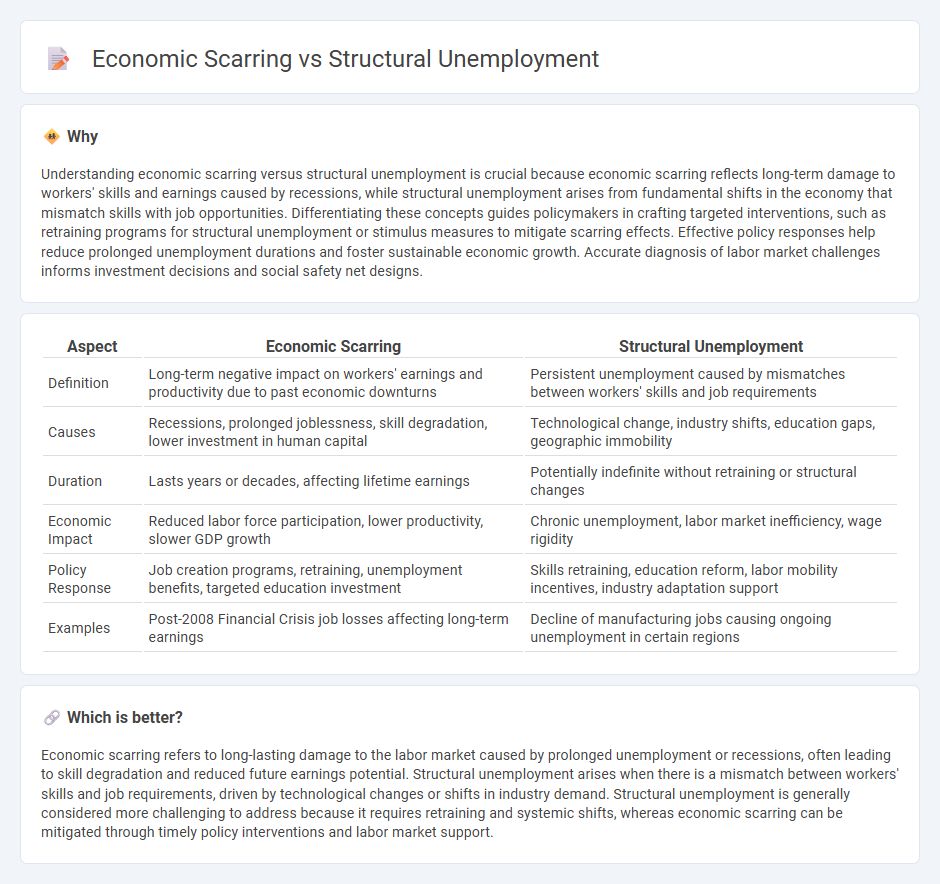
Economic scarring refers to the long-term damage to the labor market caused by prolonged recessions, resulting in reduced workforce participation and skill erosion. Structural unemployment arises when there is a mismatch between workers' skills and job market demands, often due to technological changes or shifts in industry composition. Explore deeper insights into how these phenomena impact economic recovery and labor policies.
Why it is important
Understanding economic scarring versus structural unemployment is crucial because economic scarring reflects long-term damage to workers' skills and earnings caused by recessions, while structural unemployment arises from fundamental shifts in the economy that mismatch skills with job opportunities. Differentiating these concepts guides policymakers in crafting targeted interventions, such as retraining programs for structural unemployment or stimulus measures to mitigate scarring effects. Effective policy responses help reduce prolonged unemployment durations and foster sustainable economic growth. Accurate diagnosis of labor market challenges informs investment decisions and social safety net designs.
Comparison Table
| Aspect | Economic Scarring | Structural Unemployment |
|---|---|---|
| Definition | Long-term negative impact on workers' earnings and productivity due to past economic downturns | Persistent unemployment caused by mismatches between workers' skills and job requirements |
| Causes | Recessions, prolonged joblessness, skill degradation, lower investment in human capital | Technological change, industry shifts, education gaps, geographic immobility |
| Duration | Lasts years or decades, affecting lifetime earnings | Potentially indefinite without retraining or structural changes |
| Economic Impact | Reduced labor force participation, lower productivity, slower GDP growth | Chronic unemployment, labor market inefficiency, wage rigidity |
| Policy Response | Job creation programs, retraining, unemployment benefits, targeted education investment | Skills retraining, education reform, labor mobility incentives, industry adaptation support |
| Examples | Post-2008 Financial Crisis job losses affecting long-term earnings | Decline of manufacturing jobs causing ongoing unemployment in certain regions |
Which is better?
Economic scarring refers to long-lasting damage to the labor market caused by prolonged unemployment or recessions, often leading to skill degradation and reduced future earnings potential. Structural unemployment arises when there is a mismatch between workers' skills and job requirements, driven by technological changes or shifts in industry demand. Structural unemployment is generally considered more challenging to address because it requires retraining and systemic shifts, whereas economic scarring can be mitigated through timely policy interventions and labor market support.
Connection
Economic scarring refers to the long-term damage to workers' skills and earnings caused by prolonged unemployment, which directly contributes to structural unemployment by creating a persistent mismatch between labor market demands and worker capabilities. Structural unemployment arises when certain industries decline or evolve due to technological changes or shifts in consumer preferences, leaving displaced workers unable to find jobs without retraining. This connection exacerbates economic inefficiencies and slows recovery by trapping workers in unemployment despite available job vacancies requiring different skills.
Key Terms
Labor Market Mismatch
Structural unemployment arises from persistent labor market mismatches where workers' skills or locations do not align with available job opportunities, leading to long-term joblessness despite vacancies. Economic scarring refers to the lasting negative effects of unemployment on individuals' future earnings and employability, often exacerbated by prolonged structural unemployment and inadequate retraining programs. Discover how addressing labor market mismatches can mitigate scarring and enhance employment outcomes.
Long-Term Unemployment
Structural unemployment arises from mismatches between workers' skills and job requirements, often leading to persistent long-term unemployment. Economic scarring refers to the lasting negative effects on workers' earnings, productivity, and career progression due to prolonged periods without employment. Explore the detailed dynamics and policy implications of long-term unemployment to understand its impact and potential solutions.
Human Capital Depreciation
Structural unemployment arises when there is a mismatch between workers' skills and job requirements, often leading to long-term joblessness and degradation of human capital. Economic scarring, particularly through human capital depreciation, occurs when prolonged unemployment or underemployment erodes workers' skills, knowledge, and productivity, reducing their future employment prospects and earnings. Explore how targeted retraining programs and policy interventions can mitigate human capital depreciation and combat structural unemployment effectively.
Source and External Links
Structural Unemployment - Definition, Causes, How It Works - Structural unemployment arises from a mismatch between workers' skills and job market demands, often due to technological advances or globalization, making it a long-term issue even during economic growth.
Structural unemployment - Wikipedia - It is involuntary unemployment caused by a skills gap between workers and employers, often due to technological change, requiring retraining or migration, and can be slow to resolve.
Structural Unemployment: Definition and Examples | Indeed.com - Structural unemployment is a long-lasting type caused by significant industry changes such as automation, company relocations, economic shifts, and lack of employee training programs.
 dowidth.com
dowidth.com